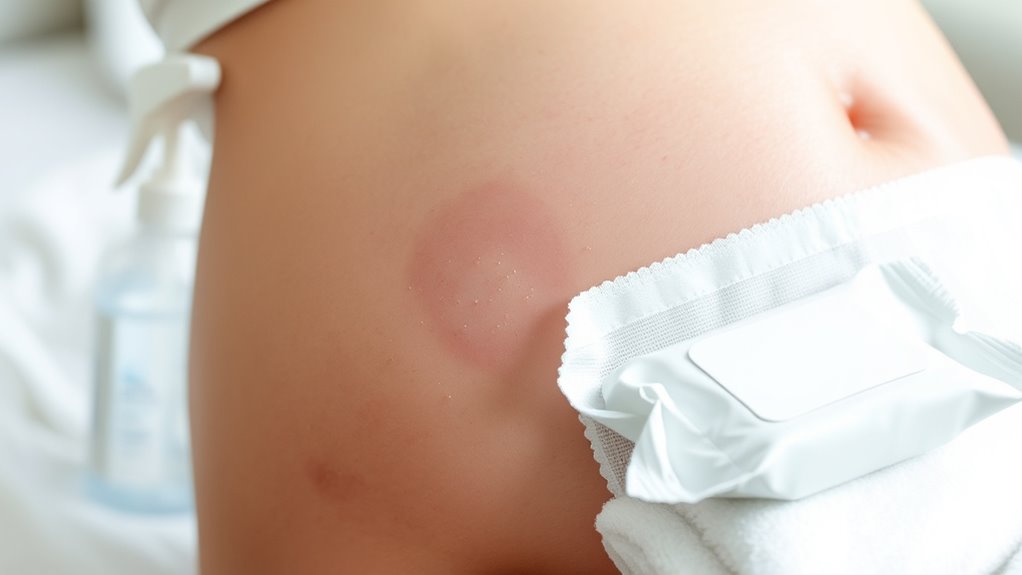After a cesarean section, you can expect to stay in the hospital for 2 to 4 days. During this time, healthcare providers will monitor your pain, incision healing, and provide support for breastfeeding and newborn care. You’ll start moving gently to prevent complications. At home, keep an eye on your incision for any signs of infection, manage pain with medications, and follow up with your healthcare provider to guarantee a smooth recovery. There’s more to learn about your recovery journey!
Key Takeaways
- Expect a hospital stay of 2 to 4 days for monitoring pain levels and incision healing after your C-section.
- Manage pain with oral medications and report any fever above 100.4°F or concerning signs immediately.
- Maintain incision care by showering gently, avoiding scrubbing, and monitoring for signs of infection.
- Engage in light movement to alleviate gas discomfort and reduce the risk of deep vein thrombosis.
- Schedule follow-up appointments around two weeks postpartum for checkups and ongoing care, including breastfeeding support.
Hospital Stay Duration and Monitoring
After a C-section, you’ll typically stay in the hospital for 2 to 4 days, depending on how well you’re recovering and any complications that may arise.
During this time, healthcare providers monitor your pain levels and the healing of your incision. They’ll also support you with breastfeeding and newborn care.
It’s important to move around a bit to prevent issues like constipation and deep vein thrombosis. Expect regular checks for signs of infection, heavy vaginal bleeding, and any unusual symptoms.
If you notice a fever above 100.4°F or other concerning signs, report them immediately. This monitoring guarantees that both you and your baby are on the right path toward recovery before heading home.
Immediate Post-Surgery Recovery

As you move from the hospital stay to your immediate post-surgery recovery, your body starts to adjust to the changes following a C-section.
Regaining sensation may take several hours, especially if you’d an epidural. You might feel groggy or nauseous if general anesthesia was used. Healthcare providers will monitor you closely for complications.
Pain management begins with oral medications after your epidural is removed, while discomfort from gas and bloating is common.
It’s important to start moving slowly—walking can help ease gas pains and prevent blood clots. Adequate rest is significant, though it may feel challenging with a newborn.
Incision Care and Hygiene

Taking proper care of your incision is essential for a smooth recovery after a C-section.
Shower as needed, allowing warm water to gently run over the incision without scrubbing. Afterward, pat it dry with a clean towel.
Monitor for signs of infection such as redness, swelling, drainage, or a foul odor. Use a pillow to support your incision when coughing or laughing, and avoid removing steri-strips until they fall off naturally, usually within a week.
Keep the area clean with mild soap and water, and change bandages daily or sooner if they get wet or dirty.
Avoid soaking in bathtubs or swimming until your healthcare provider gives you the go-ahead.
Your incision care plays an important role in your healing journey.
Effective Pain Management Strategies

Effective pain management is essential for recovery after a cesarean section, and there are various strategies to help ease your discomfort.
You might benefit from pharmacological approaches like a combination of acetaminophen, NSAIDs, and, if necessary, opioids used sparingly. Multimodal analgesia can further enhance your pain control while reducing opioid use.
Neuraxial analgesia, such as intrathecal morphine, is also common for postoperative pain relief.
Consider complementary therapies like acupuncture or massage, which may improve your satisfaction, though their efficacy varies.
Enhanced Recovery Programs (ERPs) can shorten your hospital stay and minimize pain through early mobility.
Activity Guidelines for Recovery

After managing pain effectively, it’s important to focus on activity guidelines that support your recovery.
Start with gentle walking within the first 24 hours to enhance circulation and prevent blood clots. Avoid heavy lifting, especially anything heavier than your baby, for the first 6-8 weeks, and prioritize rest alongside these gentle activities.
Start gentle walking within 24 hours to boost circulation and avoid heavy lifting for 6-8 weeks to ensure a smooth recovery.
You’ll generally stay in the hospital for 1 or 2 days post-surgery. Refrain from driving for at least 2 weeks and postpone sexual activity until after 6 weeks postpartum.
Minimize strenuous housework during the initial recovery phase, and only introduce high-impact exercises after 12 weeks.
Always monitor your recovery closely and consult your healthcare provider for personalized advice.
Emotional and Nutritional Support

While you navigate the emotional and physical recovery after a cesarean, it’s crucial to seek both emotional and nutritional support. Acknowledge your feelings—disappointment and guilt are normal. Lean on family, friends, and support groups to facilitate your recovery.
Sharing your birth experience can be therapeutic, helping you process your emotions and reduce feelings of shame.
Nutritionally, focus on a balanced diet rich in vitamins and minerals to aid healing. Stay hydrated and consider meal assistance to ease stress. Incorporate protein-rich foods for tissue repair and opt for whole, unprocessed options for quicker recovery.
Don’t hesitate to reach out for professional help if you’re struggling emotionally; prioritizing your well-being is key to a smoother recovery.
Importance of Early Mobilization

As you focus on your recovery, early mobilization can play a crucial role in minimizing complications and speeding up healing after a cesarean.
Starting to move as soon as 6 hours post-surgery can reduce risks like deep vein thrombosis and muscle stiffness. It enhances blood circulation, cutting down the need for opioid pain management.
Early ambulation not only improves breastfeeding rates but also helps you maintain a balanced diet. Additionally, it serves as a non-drug strategy to ease discomfort by releasing endorphins, leading to better overall well-being.
Follow-Up Appointments and Ongoing Care

Follow-up appointments and ongoing care are vital for your recovery after a cesarean. Typically, you’ll have a post-op appointment around two weeks after surgery, followed by a thorough checkup at six weeks.
This care is an ongoing process tailored to your specific needs, especially if you’d a high-risk pregnancy. It’s important to monitor your blood pressure, watch for signs of infection at the incision site, and seek immediate help for any severe symptoms.
You can also benefit from breastfeeding support and mental health screenings during these visits. Establishing open communication with your healthcare provider guarantees all your concerns are addressed, and you can explore options like telemedicine for added convenience.
Frequently Asked Questions
What Should I Pack for My Hospital Stay After a C-Section?
When packing for your hospital stay after a C-section, you’ll want to include essential documents like your insurance card and birth plan.
Don’t forget comfy clothing, nursing bras, and toiletries for personal care.
Bring a phone and charger for connectivity, along with a portable charger for convenience.
Consider packing high-waisted underwear, a belly binder for support, and items for pain management, like a heating pad or ice pack, to aid your recovery.
Can I Shower After My C-Section, and When?
“Cleanliness is next to godliness.”
After your C-section, you’ll typically want to wait at least 24 hours before showering, depending on how stable you feel and the condition of your incision.
Your healthcare provider will give you the best guidance based on your situation.
When you do shower, be gentle; avoid direct water pressure on the incision and use lukewarm water.
Always follow their advice to guarantee proper healing!
How Can My Partner Support Me During Recovery?
Your partner can support you during recovery in several ways.
They can take on household duties, manage meals, and handle shopping to lighten your load.
Emotional support is essential, so they should listen and reassure you as you process your experience.
Helping with the baby, like passing them during feeds or assisting with burping, makes a considerable difference.
Also, encouraging gentle movement and ensuring you rest will aid your recovery greatly.
What Signs Indicate a Complication After Surgery?
After surgery, you should watch for signs indicating complications.
If you experience a fever over 100.4°F, increased pain, or redness around the incision, it’s important to seek help. Heavy bleeding or passing large blood clots can signal issues, as can severe mood swings or overwhelming fatigue.
Additionally, chest pain, difficulty breathing, and severe abdominal pain shouldn’t be ignored. Stay alert for any unusual symptoms, and don’t hesitate to contact your healthcare provider.
When Can I Resume Sexual Activity Post-C-Section?
When can you resume sexual activity after a C-section? It’s a question that lingers in the back of your mind, isn’t it?
Typically, you should wait about 4 to 6 weeks, but it’s essential to check in with your healthcare provider at your 6-week postpartum appointment.
Listen to your body—emotional readiness and physical comfort matter. If you’re feeling pain or discomfort, it’s best to give yourself more time before diving back in.
Conclusion
In summary, managing post-cesarean care can feel overwhelming, but you’re not alone in this journey. By understanding hospital protocols, managing pain, and prioritizing your recovery, you’ll set the stage for a smoother healing process. Don’t forget the importance of emotional and nutritional support—after all, who wouldn’t benefit from a little extra care during this time? Remember to stay connected with your healthcare team, and take it one day at a time as you heal.









